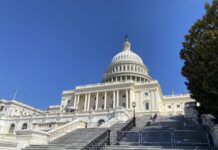
When lawmakers from the Georgia committees tasked with the once-a-decade redrawing of congressional and legislative district lines came to Columbus Wednesday, Martha Saunders made the trek down from Carroll County with two other women to share their worries about transparency when lawmakers sharpen their mapmaking pencils.
“Like many others, we are concerned about how the process will work,” she said. “Will we as citizens be made aware of the rules and guidelines that determine the outcomes? Will we be able to see drafts of maps as soon as they are drawn and be able to publicly react to those drafts?”
Saunders said she’s concerned that four different state representatives with divided attention represent parts of Carroll County, pop. 120,000 – Republican Reps. Tyler Smith of Bremen, J. Collins of Villa Rica, Lynn Smith of Newnan, Randy Nix of Lagrange, all of whom also represent territory outside of the west Georgia county.
“There is no House legislator whose sole responsibility is our county’s welfare and interests,” Saunders said. “Compactness and preservation of existing political communities are two of the criteria for drawing legislative districts. We ask that the joint appropriation and redistricting committee make the system transparent and allow all citizens to see and react to the district maps that involve their counties.”
The committee members’ whirlwind tour of the state is winding down. A Macon hearing Thursday was the last in-person meeting scheduled for the year, though lawmakers say they still plan to host a make-up hearing in the Augusta area after dangerous weather canceled one scheduled early this month, and a virtual meeting is set for Friday at 5 p.m.
More hearings needed
But while the town halls are almost over, some long for another chance to have their say on the maps in the fall — preferably once preliminary maps actually exist.
In a normal redistricting year, lawmakers would have all the population data from the U.S. Census Bureau they need to start crafting maps by March, but with the headcounts delayed last year because of the pandemic, that data is not expected to reach states until Aug. 16, according to the U.S. Census Bureau. Sometime after that, Gov. Brian Kemp is due to call a special session of the state Legislature to hash out the maps’ details.
That delay will probably leave no time for public hearings after the data comes in, said Rep. Bonnie Rich, the Suwanee Republican who chairs the House Legislative and Congressional Reapportionment Committee. Qualifying begins next spring for state legislative and congressional office, and candidates need to know which district they live in before they decide to run.
“We are going to be on an extremely compressed timeline to draw the maps before we need to qualify for elections,” Rich said at Wednesday’s hearing at Columbus State University. “A lot of people are asking us to make this tour a second time, and I don’t know that that’s going to be physically possible in order for us to meet our legal requirements to draw these maps.”
But not allowing public comment on proposed maps would mean people like Saunders would have no recourse if lawmakers do not listen to their concerns, said Ken Lawler, chair of the non-partisan anti-gerrymandering group Fair Districts Georgia.
“These listening sessions that we’re doing now are fine, but they’re not enough. The public wants to see the maps and be able to (have) input and comment on the maps themselves,” he said. “That’s where the public can have the most impact is commenting on the maps, and if we don’t get hearings when the maps are out, some extensive public hearings, then there’s really no chance to influence them after that.”
The sooner Gov. Brian Kemp approves the maps, the easier things will be for the candidates on the ballot in 2022, but Georgia has no law that specifies when redistricting has to occur, Lawler said.
“Our thinking is that there should be enough time to hold hearings on the maps themselves, besides just the special session, which tends to be a very short affair,” he said. “There should be enough time to go back around the state and give the public a chance to comment on the maps.”
Still no guidelines
Also not scheduled until after the public hearings are over is the approval of the guidelines the lawmakers will use to create the maps.
Last decade’s guidelines outlined important aspects of the process like general principles for map drawing, limits for public access to documents, and the requirements for submitting a proposed or alternative map.
Still, those committee rules do not have the force of law behind them — in 2011, lawmakers built themselves an escape hatch in their list of criteria for creating district boundaries: “The identifying of these criteria is not intended to limit the consideration of any other principles or factors that the Committee deems appropriate.”
Fair Districts and other advocacy groups submitted their own proposed guidelines in April, a list that includes the immediate release of maps on a public website, the publication of factors leading to the creation of boundaries, and an analysis of how the proposed borders will affect minority communities. As of Thursday, the group has not received a response, Lawler said.
Georgia transparency law loopholes also make it more difficult for open government advocates to get a glimpse into the proverbial smoke-filled rooms.
“All of this is secret because of the way the laws are written,” Lawler said. “It’s not enough to say the guidelines are not very good. The General Assembly is not subject to the Open Meetings Act, the Open Records Act, and there are some provisions in the law that specifically draw a privileged circle around all the communications with the staff people and the committees that do this work. It’s only when they’re meeting in a public hearing that you see what’s going on. So, unfortunately, we have structural problems. And in the long run, that’s what’s got to get changed.”
Incentives to change
Change is unlikely, said University of Georgia political science professor Charles Bullock. For now, Republicans can use their power to protect their majority, and whenever Democrats take back control, they, too, will be tempted to wield power to cement their authority.
“People would like to see this done in an open forum. It ain’t going to happen,” Bullock said. “It never has, it probably never will, as long as it’s being done by partisans. Maps will be drawn, probably, by technicians in the Georgia reapportionment office with a good deal of input from Republicans. Democrats, the first time they see it may be the first time that the public sees it.”
States in which citizens can initiate votes on constitutional amendments have had an easier time reforming their redistricting process, but in states like Georgia, in which citizens do not have that right, advocates have to rely on lawmakers willingly giving up power.
That’s been rare, but it happened in Virginia last November when voters approved a constitutional amendment putting the power to redraw map lines in the hands of a nonpartisan commission rather than the state’s General Assembly.
The measure found enough support from lawmakers to pass as the state’s Republican majority fell into jeopardy. There’s a chance that could happen in Georgia, but Bullock said it’s not likely anytime soon.
“Maybe in 10 years,” he said. “Right now, Republicans have a trifecta, they get to draw the maps, and there’s no need for them to give up their power now. Some way well into the decade, Republicans may size up the situation, and if they say, ‘We don’t think we’re going to be able to maintain a majority in both chambers.’ At that point, they might say, ‘Let’s give this to an independent commission.’ But right now, I don’t think Republicans think they will be unable to maintain a majority.”






